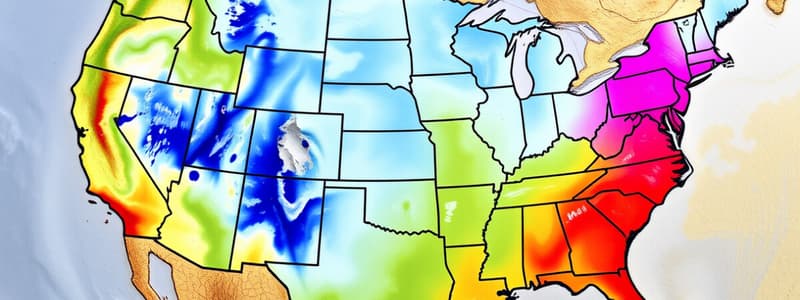Podcast
Questions and Answers
What are the main characteristics of spring in the United States?
What are the main characteristics of spring in the United States?
Warming temperatures and increased rainfall, with tornado season peaking in the Great Plains.
Describe the summer climate in the Southeast and Southwest regions of the U.S.
Describe the summer climate in the Southeast and Southwest regions of the U.S.
The Southeast experiences hot and humid summers, while the Southwest is dry and hot.
What is a key weather phenomenon associated with fall in the United States?
What is a key weather phenomenon associated with fall in the United States?
Hurricane season occurs in the Atlantic during the fall.
How do winter conditions vary across different regions in the U.S.?
How do winter conditions vary across different regions in the U.S.?
What type of climate is predominant in the Northeast region of the U.S.?
What type of climate is predominant in the Northeast region of the U.S.?
Describe the precipitation patterns across the United States.
Describe the precipitation patterns across the United States.
What climatic features are common in the Pacific Northwest?
What climatic features are common in the Pacific Northwest?
What temperature variation is observed in desert areas during the day and night?
What temperature variation is observed in desert areas during the day and night?
How does coastal influence affect temperatures on the West Coast?
How does coastal influence affect temperatures on the West Coast?
What is the urban heat island effect?
What is the urban heat island effect?
Flashcards are hidden until you start studying
Study Notes
Climates in the United States
Seasonal Variations
-
Spring (March - May):
- Warming temperatures; increased rainfall in many regions.
- Tornado season peaks in the Great Plains.
-
Summer (June - August):
- Hot and humid in the Southeast; dry and hot in the Southwest.
- Thunderstorms common in the Midwest.
-
Fall (September - November):
- Cooling temperatures; foliage change in Northern regions.
- Hurricane season in the Atlantic.
-
Winter (December - February):
- Varies significantly; cold and snowy in the Northeast and Midwest.
- Mild winters in the South and Pacific Coast.
Regional Climate Zones
-
Northeast:
- Humid continental; cold winters and warm summers.
-
Southeast:
- Humid subtropical; hot summers and mild winters; frequent rainfall.
-
Midwest:
- Humid continental; temperature extremes; cold winters and hot summers.
-
Southwest:
- Arid and semi-arid; hot summers, mild winters; low precipitation.
-
West Coast:
- Mediterranean; mild, wet winters and dry summers.
-
Rocky Mountains:
- Alpine; significant elevation changes lead to varied climates.
-
Northern States (e.g., Alaska):
- Subarctic and Arctic; long, harsh winters and short summers.
Precipitation Patterns
-
General Trends:
- Precipitation decreases from east to west across the country.
-
Northeast:
- High levels of rainfall, especially in summer.
-
Southeast:
- Abundant rainfall throughout the year; prone to tropical storms.
-
Great Plains:
- Moderate precipitation; can be variable; droughts common.
-
Southwest:
- Low annual rainfall; monsoon season brings occasional heavy rain.
-
Pacific Northwest:
- Very high precipitation; coastal regions receive the most rain, especially in winter.
Temperature Fluctuations
-
Seasonal Temperature Changes:
- Varies by region; extreme in the Midwest and Northeast.
-
Diurnal Temperature Variation:
- More pronounced in desert areas (Southwest) where nights can be much cooler.
-
Coastal Influence:
- Temperatures moderated by ocean currents; cooler summers and warmer winters on the West Coast.
-
Urban Heat Islands:
- Cities often experience higher temperatures than surrounding rural areas due to human activities and infrastructure.
Seasonal Variations
- Spring spans March to May, marked by warming temperatures and increased rainfall, particularly in certain regions.
- Tornado season peaks in the Great Plains during Spring, leading to heightened severe weather activity.
- Summer, from June to August, is characterized by hot, humid conditions in the Southeast and dry heat in the Southwest, with frequent thunderstorms in the Midwest.
- Fall occurs from September to November, bringing cooling temperatures and foliage changes in Northern regions, along with the Atlantic hurricane season.
- Winter, lasting December to February, shows significant variability; cold and snowy conditions dominate the Northeast and Midwest, while the South and Pacific Coast experience milder winters.
Regional Climate Zones
- The Northeast features a humid continental climate with cold winters and warm summers.
- The Southeast has a humid subtropical climate, characterized by hot summers, mild winters, and ample rainfall.
- The Midwest, similar to the Northeast, exhibits a humid continental climate with temperature extremes, cold winters, and hot summers.
- The Southwest is classified as arid or semi-arid, experiencing hot summers, mild winters, and low overall precipitation.
- The West Coast enjoys a Mediterranean climate, featuring mild, wet winters and dry summers.
- The Rocky Mountains present an alpine climate, with significant elevation changes leading to diverse climatic conditions.
- Northern states, exemplified by Alaska, show subarctic and Arctic climates, characterized by long, harsh winters and short summers.
Precipitation Patterns
- Precipitation generally decreases from the eastern to western regions of the country.
- The Northeast receives high levels of rainfall, particularly in the summer months.
- The Southeast enjoys abundant rainfall year-round and is susceptible to tropical storms.
- The Great Plains experience moderate, variable precipitation often leading to drought conditions.
- The Southwest sees low annual rainfall, but the monsoon season can bring periods of heavy rain.
- The Pacific Northwest is known for very high precipitation, especially in winter, with coastal areas receiving the greatest amounts.
Temperature Fluctuations
- Seasonal temperature changes vary by region, with the Midwest and Northeast experiencing the most extreme fluctuations.
- In desert areas, particularly the Southwest, diurnal temperature variation is significant, often resulting in much cooler nights.
- Coastal regions benefit from moderated temperatures due to ocean currents, resulting in cooler summers and warmer winters along the West Coast.
- Urban heat islands occur in cities, where human activity and infrastructure lead to higher temperatures compared to surrounding rural areas.
Studying That Suits You
Use AI to generate personalized quizzes and flashcards to suit your learning preferences.




